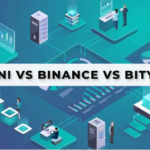Key Takeaways:
- Higher interest rates may dull the luster of some crypto investments by providing savers with the chance to safeguard more substantial benefits in a lower-risk environment.
- The opportunity cost of capital rises when interest rates rise. The US government is offering 9.5 percent inflation-protected bonds that are primarily risk-free (with a $10,000 limit).
- So, for every dollar you give to the most trusted institution on the globe, you get $0.10 back every year. To even break with the Treasury yield, validators’ fees must double or their stake must be cut in half.
Bitcoin has little experience with higher interest rates, posing risks for investors hoping to profit from its precipitous drop. The cryptocurrency has plummeted along with other risk assets such as tech stocks since the Fed raised rates, having to send them on a path that is supposed to hit 3% early next year. Bitcoin emerged from the ashes of the 2007/08 economic crisis, and its network went live in January 2009. This somewhat appears to imply that the world’s largest cryptocurrency has profited from a period of super interest rates for the majority of its establishment.
Bitcoin has dropped to $29,731, its lowest level since July 2021, after falling nearly 12% in the earlier week, perhaps the worst weekly loss since January.
“This isn’t the first time we’ve reached this level, and the risk-reward ratio for picking up bitcoin here has been very good in the last year or so,” said Matt Dibb, COO of Stack Funds, a Singapore-based cryptocurrency platform.
Higher interest rates, in general, indicate a decreased appetite for high-risk/high-reward assets such as cryptocurrencies. In theory, this means that the crypto market will see price declines at various points this year, though increases are likely to be modest (e.g., 0.25 percent per pop), which may not tamp down investor appetite for risk far beyond the initial impact of each hike.
Aside from interest rate forecasts, it’s worth considering bitcoin’s unexpected behavior during the cost-of-living crisis.
Bullish adoption news from large financial institutions can also drive prices higher, while talk of regulations and bans can cause prices to fall.
The halving cycle of Bitcoin, which reduces the number of new BTC entering circulation every four years, also plays a role. The next 50 percent cut is scheduled for 2024.
What Does This Imply for Cryptocurrency?
Increasing interest rates will be disastrous for the crypto market right now. Analysts predict that the market will continue to stay bumpy in the near run.
We’ve already seen the crypto market battle because people are wary of investing in high-risk assets like crypto. While cryptocurrencies have already demonstrated to be an excellent store of value in the face of deteriorating economic conditions, the inherent danger of these assets, as well as their volatility, is making investors more skeptical.
Experts believe that the market is currently in for a lengthy pullback.
This could actually be beneficial to investors. Bear markets are ideal for buying on the cheap and waiting for a rebound. And if the cryptocurrency market has taught us anything, it’s that prices eventually rise and investors recoup their losses.
When the Federal Reserve met on January 26, BTC fell from around $38,000 to $35,600. This was a 6% drop in less than 24 hours.
In fact, the Fed’s detrimental impact on bitcoin and crypto dates back further: on January 5, the FOMC released its December 14-15 minutes, in which it indicated that it was likely to raise rates in 2022.
Following this publishing, BTC fell from $46,500 to $43,200 in a matter of hours, before falling to $41,500 a few days later, portraying a 10% drop.
And, since the publication on January 5, BTC and crypto have been on a longer-term downhill slide, with the cryptocurrency market losing 21.7 percent of its total value. In other words, the Fed’s growing belligerence has had a compounding impact on crypto, dispiriting investor confidence in anticipation of tighter monetary policy.
@jonwu_ elaborates, When interest rates rise, so does the opportunity cost of capital. The US government is offering inflation-protected bonds at 9.5 percent, which are primarily risk-free (with a $10,000 limit).
So you have to wonder why 5 percent paid in down only native tokens is appealing
.
Validators are economic actors who seek a return on committed capital that exceeds the risk-free rate. Validators, which are essentially web2 cloud infrastructure companies, are using the capital asset, pricing model:
Run servers and receive a recurring cash flow.
So, in order for validators to earn a higher return, one of two things must occur:
– Fee revenue increases; or – The buy-in (stake) decreases
This is an appalling prospect for a network in a downturn.
@jonwu.aztec reveals that for every $1 you give to the most trusted institution on the planet, you get $0.10 back every year.
Consider for a moment that a network’s staking yield is 5%.
To even break even with the Treasury yield, validators’ fees must double or their stake must be cut in half.
You can also increase fee yield in one of two ways:
1a) Increased network capacity and revenue
1b) Fewer validators (higher likelihood of block production)
The user discusses how reducing the validator set will increase centralization. Naturally, if the rate of return is lower than the alternative (giving cash to the Treasury for a ten percent annual return), some operators will wonder what the point of all that pain is and will leave.
Validators who leave will sell their stake to recover their capital commitment, putting downward pressure on the token price.
Given the underlying interest rate environment, there will eventually be a balance where the marginal validator has a rational rate of return.
To summarise, the higher interest rates go, the more they will cause: Token prices to fall, Security to fall, and Centralization to rise.
This, according to the user, is why massive decentralization is important.
During a bull market, network activity increases, validator sets grow, and returns and token prices rise. Everything appears to be in order, but in “the bear, the chains that go full goblin-town will be tested.”
Then There’s Another Factor to Consider:
And there’s another factor to consider: it’s not just crypto markets that are falling. Equity markets have also fallen as investors fear that global central banks are ready to send economies into recession in order to control inflation.
“What’s interesting is that, while bitcoin hasn’t dropped as much as the Nasdaq or some other asset classes, the correlation between them has tightened. It’s a stronger correlation than we’ve seen in the past, “Benjamin Dean, director of digital assets at WisdomTree in London, concurred. According to Arcane Research, BTC’s correlation to the stock market is at its highest level since October 2020.
This means that the digital asset is basically moving in lockstep with the S&P 500, both down and up.
“We’re hearing from investors in some family offices that are liquidating crypto because they’re liquidating other assets, and they need to make it up on their book for this quarter to show that they’re not dying in everything and that they’ve got some money on the side to get back into equities when they bottom out,” Dibb of Stack Funds said.










